A Study of Fast Front Transients of an HVDC Mixed Transmission Line Exposed to Bipolar Lightning Strokes
Abstract
1. Introduction
2. Modeling Methodology
2.1. Line Insulation
2.2. Line Design
2.3. Tower Representation
2.4. Tower Footing Resistance
2.5. Cable Line
2.6. Surge Arrester Model
2.7. Bipolar Lightning Stroke Parameters
- two peak current magnitudes of lightning strokes (positive and negative);
- two rise and decay times;
- the mid-interval between the first and the subsequent stroke;
3. Results and Discussion
3.1. Case Study 1: Stroke on OHPC
3.2. Case Study 2: Stroke on OHGW
3.3. Effect of Tower Footing Impedance
4. Conclusions
- (1)
- In the case of a bipolar stroke on OHGW, the voltage stress caused insulator flashover of the positive pole due to the subsequent lightning stroke and the contribution of reflected waves from the first stroke. For unipolar lightning strokes, BFO occurs only under exceptional lightning and grounding conditions. Meanwhile, in this work, it is obvious from Table 5 that extreme lightning parameters are not selected; hence, there is a high likelihood of insulator flashover for bipolar lightning strokes.
- (a)
- BFO occurred at the adjacent tower due to the subsequent stroke when the footing resistance of the tower and the riser section length were both large. At smaller riser section lengths, no BFO took place despite the varying footing resistance due to reflection waves from the cable entrance, the adjacent tower, and its neighboring tower base. Strong backward reflected waves from the cable entrance at shorter riser section lengths compensate for the effect of increased footing resistance of the adjacent tower, and no BFO occurred despite the rising footing resistance. Similarly, no BFO took place with a smaller tower footing resistance and varying riser section lengths.
- (b)
- At the subsequent tower with riser section lengths greater than 150 m, no BFO occurred due to sufficient attenuation of the backward reflected waves from the cable entrance.
- (2)
- The SF of the positive OHPC caused overvoltage at the cable terminals, which was above the LIPL of the cable, and the energy dissipated by SA increased with decreasing cable lengths.
- (3)
- The small propagation time in shorter cables enabled the constructive superposition of the forward and backwards traveling waves, particularly in cables shorter than 10 km, and the voltage at the receiving end of the cable was greater than that at the sending end.
- (4)
- No BFO took place under normal conditions after applying the SA on the cable terminals for the adjacent and subsequent towers. However, for the worst choices of tower footing and riser section lengths for the adjacent tower, insulator failure occurred despite the application of SA.
Author Contributions
Funding
Data Availability Statement
Conflicts of Interest
References
- Jovcic, D. High Voltage Direct Current Transmission: Converters, Systems and DC Grids; John Wiley & Sons: Hoboken, NJ, USA, 2019. [Google Scholar]
- Overvoltages on HVDC Cables: Final Report. In Brochures: International Conference on Large High Voltage Electric Systems; CIGRE Green Books; Springer: Cham, Swizterland, 1994.
- Balog, G.; Gustavsen, B. Transient voltages affecting long cables. ELECTRA 2005, 15, 23–27. [Google Scholar]
- Shim, E.; Woo, J.; Han, S.; Moon, J. Lightning characteristics in Korea and lightning performance of power systems. In Proceedings of the IEEE/PES Transmission and Distribution Conference and Exhibition, Yokohama, Japan, 6–10 October 2002; Volume 1, pp. 534–539. [Google Scholar]
- Rakov, V. A review of positive and bipolar lightning discharges. Bull. Am. Meteorol. Soc. 2003, 84, 767–776. [Google Scholar] [CrossRef]
- Wagner, C. Electrical Transmission and Distribution: Reference Book; Westinghouse Electric Corporation: Pittsburgh, PA, USA, 1950. [Google Scholar]
- Schulz, W.; Diendorfer, G. Bipolar flashes detected with lightning location systems and measured on an instrumented tower. In Proceedings of the VII International Symposium on Lightning Protection, Curitiba, Brazil, 17–21 November 2003; University of Sao Paulo Institute of Electrotechnics and Energy: Curitiba, Brazil, 2003; pp. 6–9. [Google Scholar]
- Grebovic, S.; Pack, S.; Sadovic, S. An EMTP–RV based analysis of the line surge arrester energy duty due to lightning discharges. In Proceedings of the International Conference on Power Systems Transients IPST2015, Cavtat, Croatia, 15–18 June 2015. [Google Scholar]
- Grebovic, S.; Balota, A.; Oprasic, N. Lightning outage performance of power distribution line located in Mountain Lovćen area. In Proceedings of the 2020 9th Mediterranean Conference on Embedded Computing (MECO), Budva, Montenegro, 8–11 June 2020; pp. 1–4. [Google Scholar]
- Grebovic, S.; Oprasic, N. Influence of lightning channel impedance and nonuniform tower footing resistance distribution on line surge arrester energy duty. In Proceedings of the 2018 IEEE PES Innovative Smart Grid Technologies Conference Europe (ISGT-Europe), Sarajevo, Bosnia and Herzegovina, 21–25 October 2018; pp. 1–5. [Google Scholar]
- Geri, A. Behaviour of grounding systems excited by high impulse currents: The model and its validation. IEEE Trans. Power Deliv. 1999, 14, 1008–1017. [Google Scholar] [CrossRef]
- Greenfield, E. Transient behavior of short and long cables. IEEE Trans. Power Appar. Syst. 1984, PAS-103, 3193–3203. [Google Scholar] [CrossRef]
- Adi, N.; Vu, T.T.N.; Teyssèdre, G.; Baudoin, F.; Sinisuka, N. DC model cable under polarity inversion and thermal gradient: Build-up of design-related space charge. Technologies 2017, 5, 46. [Google Scholar] [CrossRef]
- Asif, M.; Lee, H.Y.; Khan, U.A.; Park, K.H.; Lee, B.W. Analysis of transient behavior of mixed high voltage dc transmission line under lightning strikes. IEEE Access 2018, 7, 7194–7205. [Google Scholar] [CrossRef]
- Silva, F.F.; Pedersen, K.S.; Bak, C.L. Lightning in hybrid cable-overhead lines and consequent transient overvoltages. In Proceedings of the International Conference on Power System Transients. International Conference on Power Systems Transients, IPST 2017, Seoul, Korea, 26–29 June 2017. [Google Scholar]
- Colla, L.; Gatta, F.; Geri, A.; Lauria, S. Lightning overvoltages in hv-ehv “mixed” overhead-cable lines. In Proceedings of the International Conference on Power Systems Transients, Lyon, France, 4–7 June 2007. [Google Scholar]
- Morched, A.; Gustavsen, B.; Tartibi, M. A universal model for accurate calculation of electromagnetic transients on overhead lines and underground cables. IEEE Trans. Power Deliv. 1999, 14, 1032–1038. [Google Scholar] [CrossRef]
- Mangelrød, B.G.G.I.R.; Kent, D.B.K. Transmission line models for the simulation of interaction phenomena between parallel AC and DC overhead lines. In Proceedings of the International Conference on Power Systems Transients, Budapest, Hungary, 20–24 June 1999. [Google Scholar]
- Furgał, J. Influence of lightning current model on simulations of overvoltages in high voltage overhead transmission systems. Energies 2020, 13, 296. [Google Scholar]
- Motoyama, H. Experimental study and analysis of breakdown characteristics of long air gaps with short tail lightning impulse. IEEE Trans. Power Deliv. 1996, 11, 972–979. [Google Scholar] [CrossRef]
- Cigre, W.G. Guide to procedures for estimating the lightning performance of transmission lines. CIGRE SC33 1991, 10, 31–33. [Google Scholar]
- Goll, F.; Witzmann, R. Lightning protection of 500-kV DC gas-insulated lines (GIL) with integrated surge arresters. IEEE Trans. Power Deliv. 2015, 30, 1602–1610. [Google Scholar] [CrossRef]
- LaForest, J. Transmission-Line Reference Book. 345 kV and Above; Technical Report; Large Transformer Div.; General...; General Electric Co.: Pittsfield, MA, USA, 1981. [Google Scholar]
- Martinez, J.A.; Castro-Aranda, F. Tower modeling for lightning analysis of overhead transmission lines. In Proceedings of the IEEE Power Engineering Society General Meeting, San Francisco, CA, USA, 12–16 June 2005; pp. 1212–1217. [Google Scholar]
- Maekawa, Y. Research and development of DC+/-500 kV extruded cables. CIGRE 2002. [Google Scholar]
- IEEE Guide for the Connection of Surge Arresters to Protect Insulated, Shielded Electric Power Cable Systems; IEEE Std 1299–996; IEEE: Piscataway, NJ, USA, 1997.
- IEEE working group 3.4.11 application of surge protective devices subcommittee surge protective devices committee. Modeling of metal oxide surge arresters. IEEE Trans. Power Deliv. 1992, 7, 302–309. [Google Scholar]
- Tian, Y.; Qie, X.; Lu, G.; Jiang, R.; Wang, Z.; Zhang, H.; Liu, M.; Sun, Z.; Feng, G. Characteristics of a bipolar cloud-to-ground lightning flash containing a positive stroke followed by three negative strokes. Atmos. Res. 2016, 176, 222–230. [Google Scholar] [CrossRef]
- Han, Y.; Li, L.; Chen, H.; Lu, Y. Influence of modeling methods on the calculated lightning surge overvoltages at a UHVDC converter station due to backflashover. IEEE Trans. Power Deliv. 2012, 27, 1090–1095. [Google Scholar] [CrossRef]
- Zhou, H.; Diendorfer, G.; Thottappillil, R.; Pichler, H.; Mair, M. Upward bipolar lightning flashes observed at the gaisberg tower. In Proceedings of the 2010 30th International Conference on Lightning Protection (ICLP), Cagliari, Italy, 13–17 September 2010; pp. 1–5. [Google Scholar]
- Bewley, L.V. Traveling waves on transmission systems. Trans. Am. Inst. Electr. Eng. 1931, 50, 532–550. [Google Scholar] [CrossRef]
- Eriksson, A. An improved electrogeometric model for transmission line shielding analysis. IEEE Trans. Power Deliv. 1987, 2, 871–886. [Google Scholar] [CrossRef]
- IEEE Working Group. IEEE Guide for Improving the Lightning Performance of Transmission Lines; IEEE Press: New York, NY, USA, 1997. [Google Scholar]
- Mikropoulos, P.; Tsovilis, T. Lightning attachment models and maximum shielding failure current of overhead transmission lines: Implications in insulation coordination of substations. IET Gener. Transm. Distrib. 2010, 4, 1299–1313. [Google Scholar] [CrossRef]
- Asif, M.; Lee, H.Y.; Park, K.H.; Shakeel, A.; Lee, B.W. Assessment of overvoltage and insulation coordination in mixed HVDC transmission lines exposed to lightning strikes. Energies 2019, 12, 4217. [Google Scholar] [CrossRef]

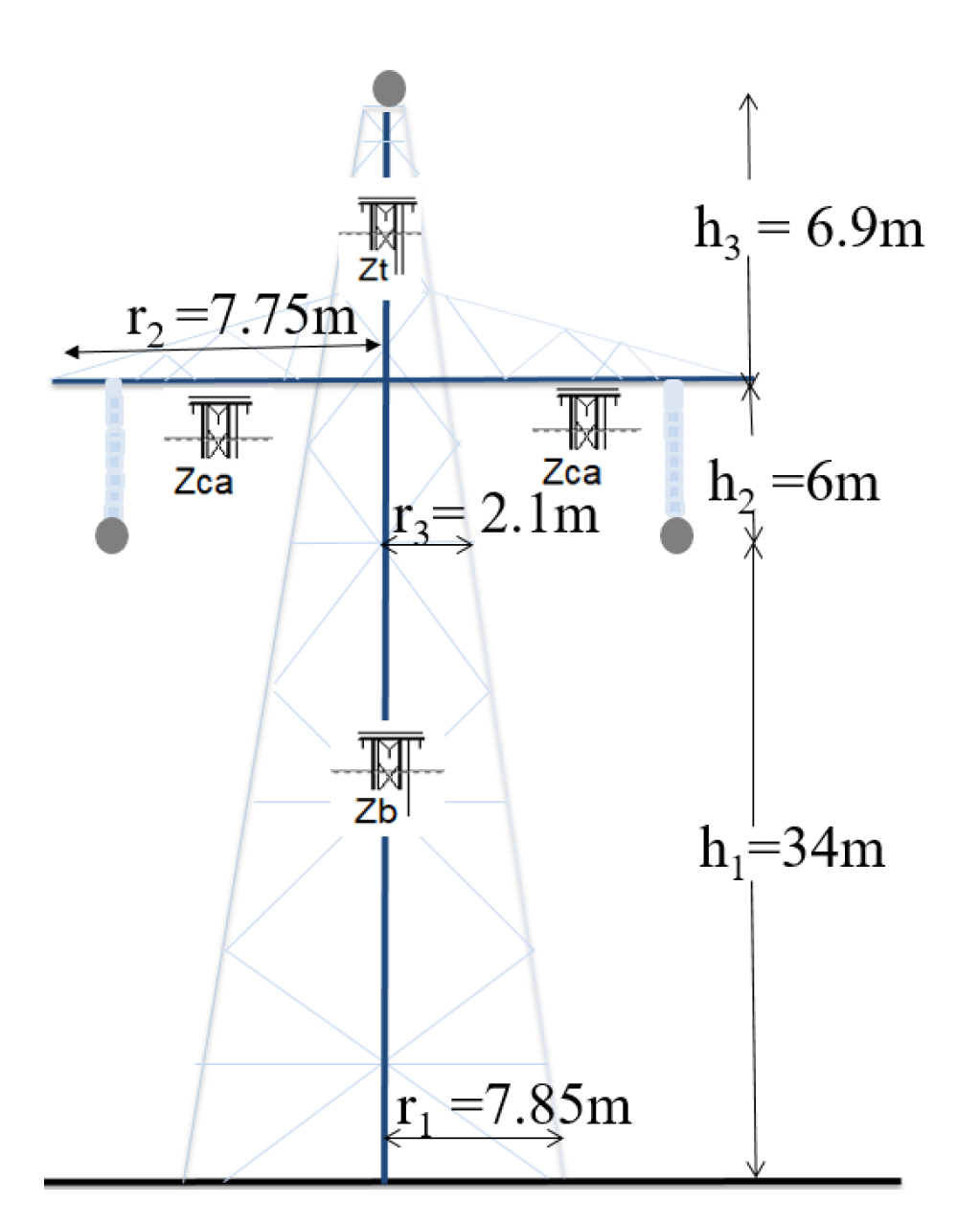
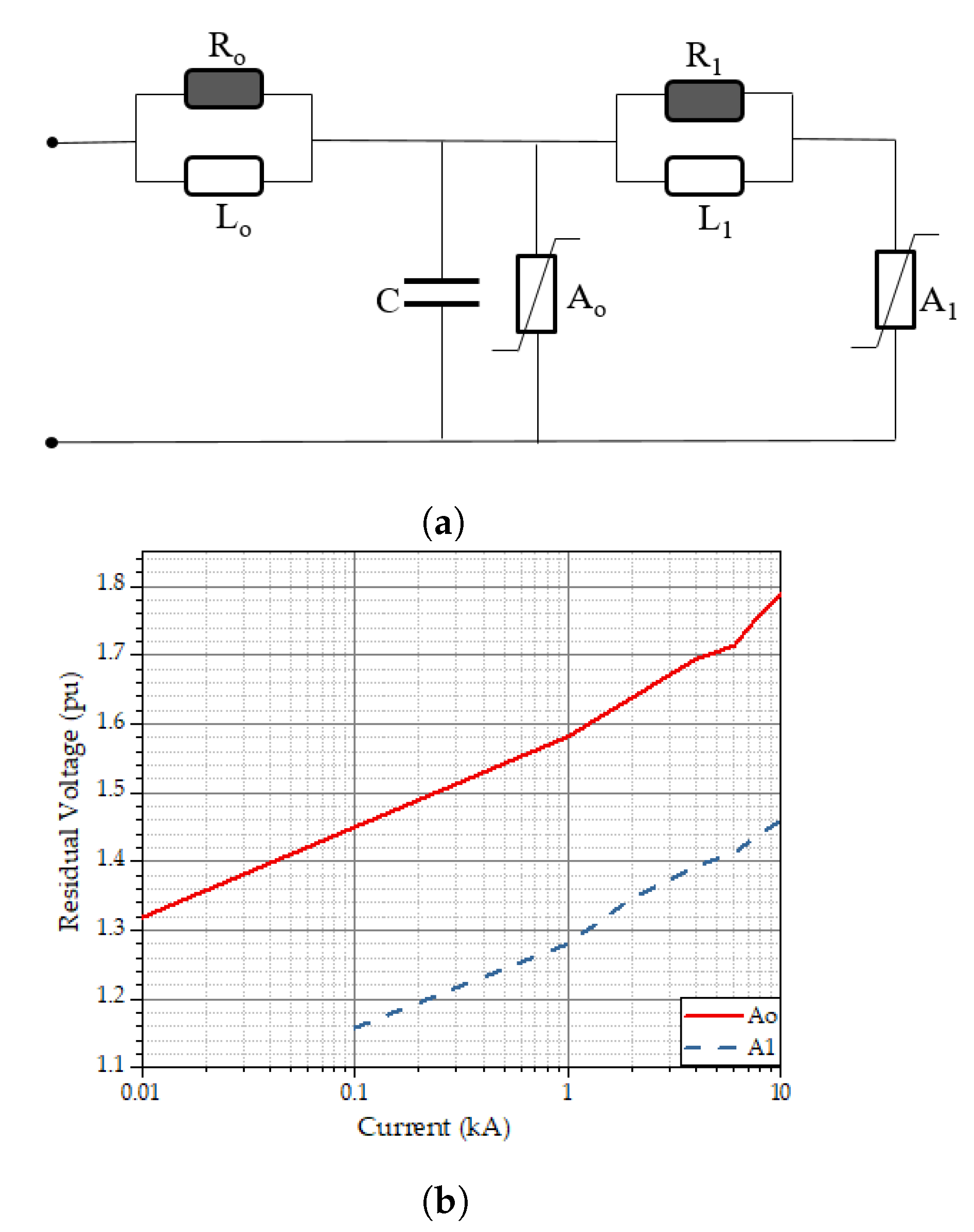

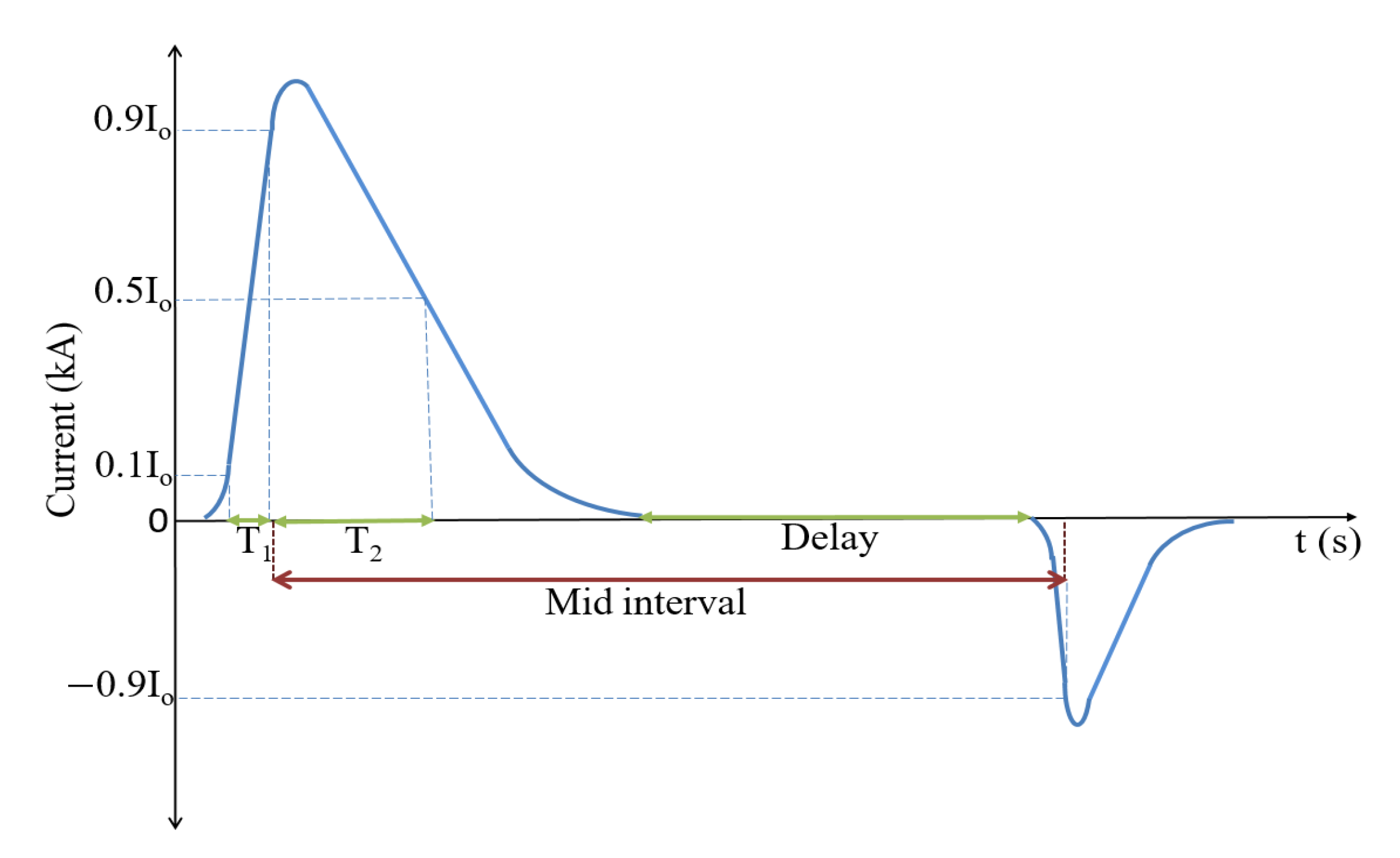
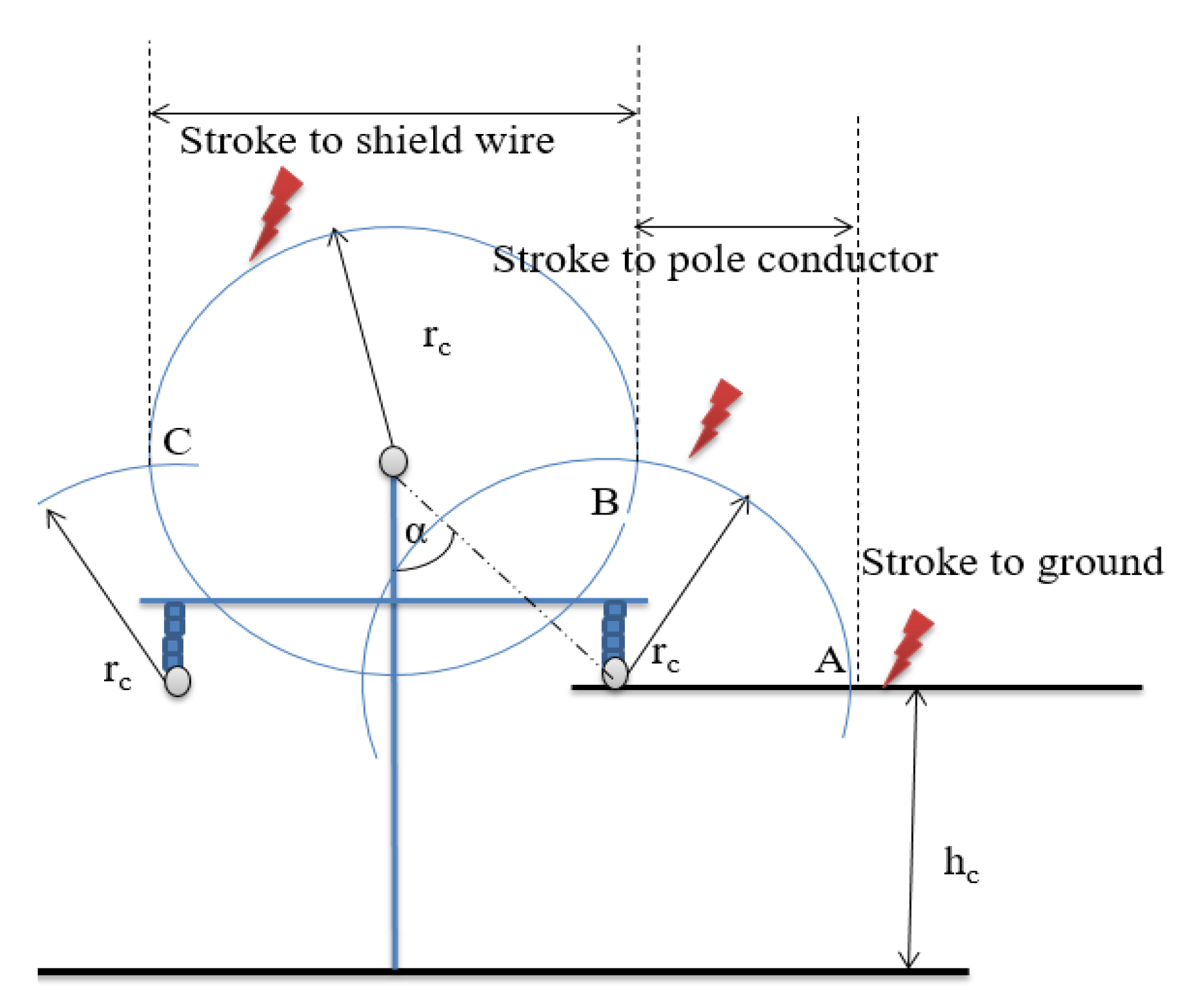
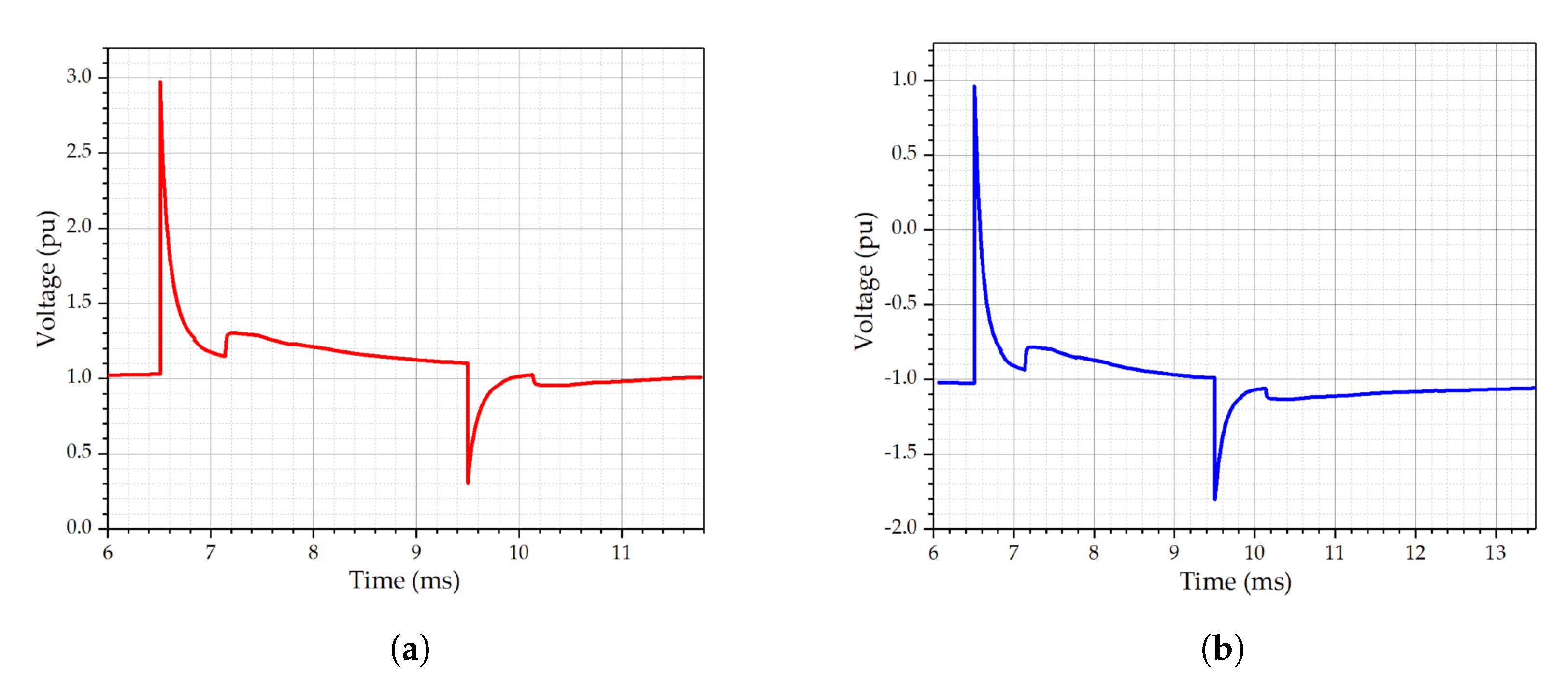
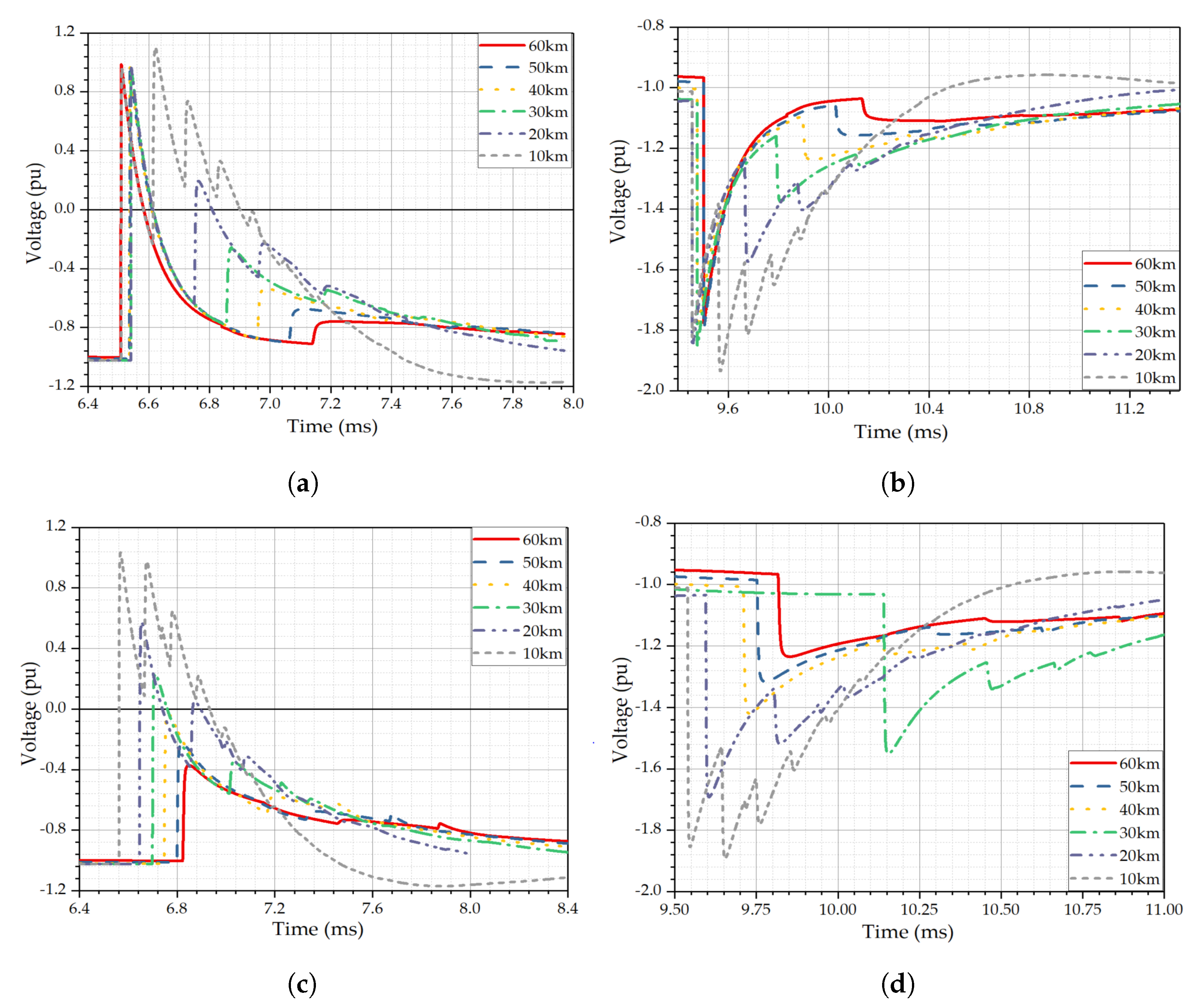


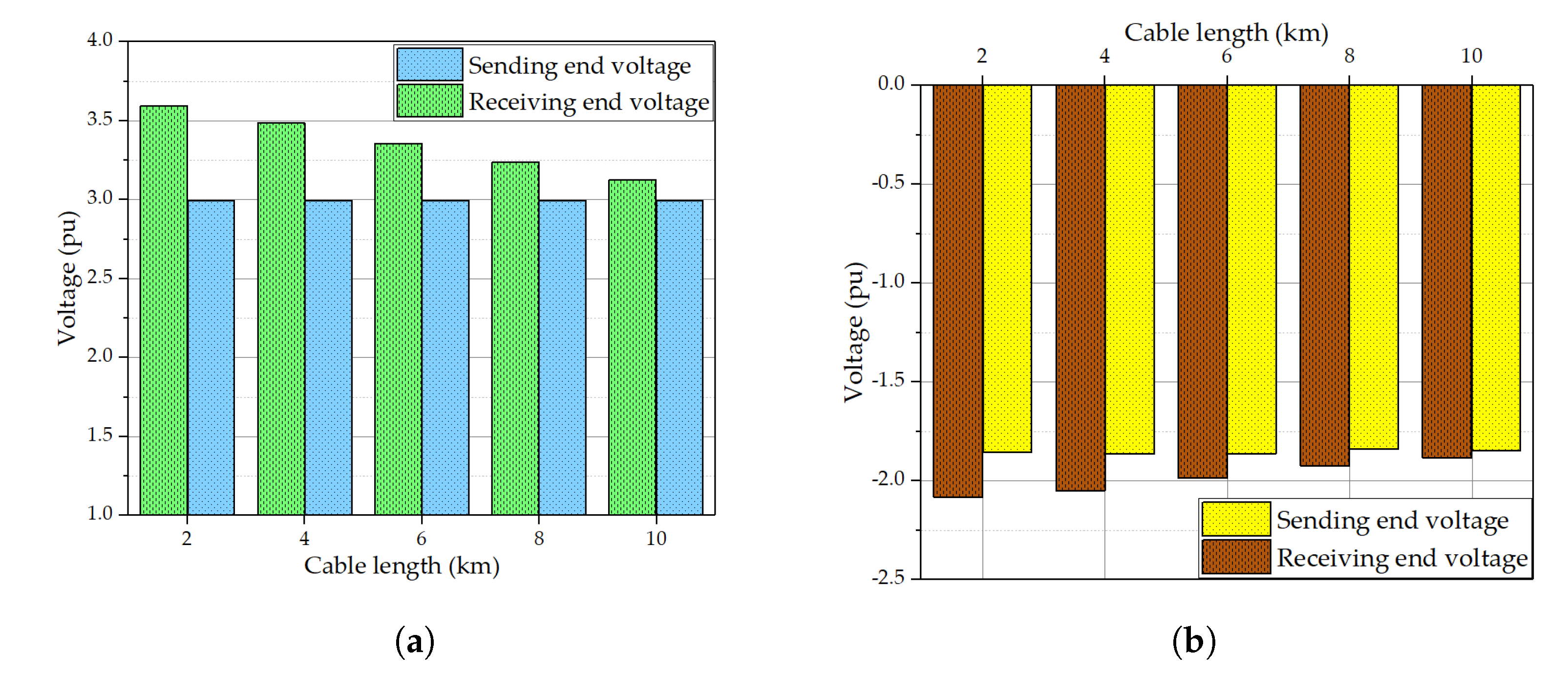
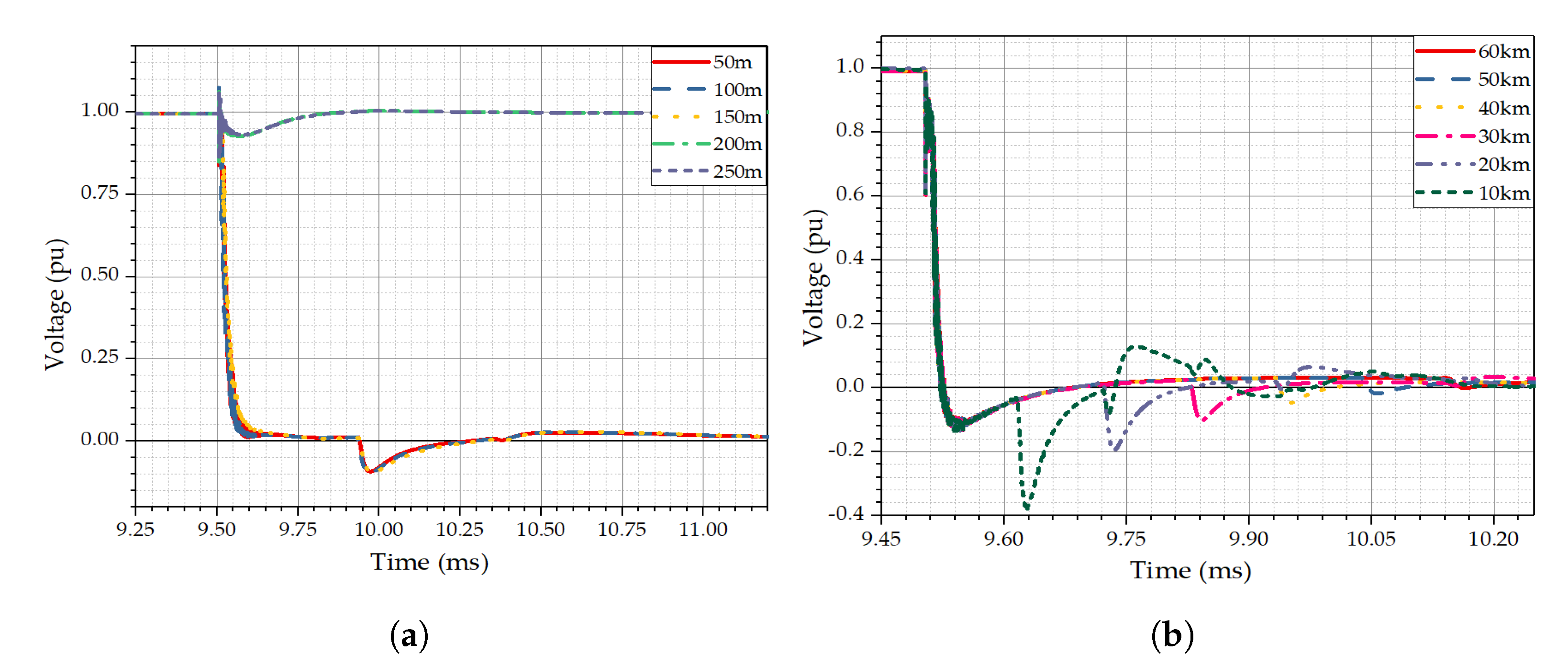
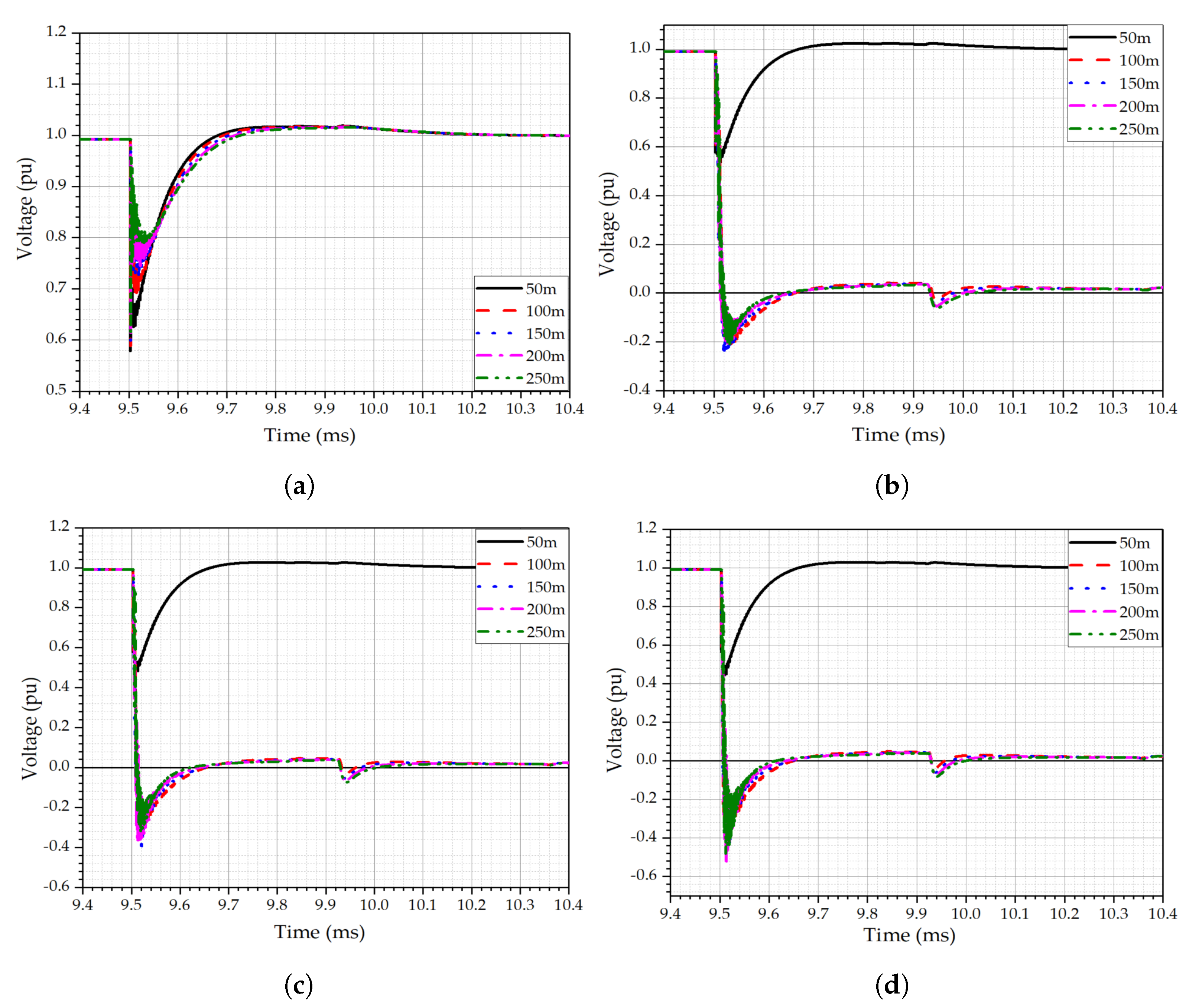
| Configuration | Polarity | k | |
|---|---|---|---|
| mkVs | kVm | ||
| arc horns | + | 0.8 | 600 |
| − | 1.0 | 670 | |
| cap and pin insulators | + | 1.2 | 520 |
| − | 1.3 | 600 |
| Quantity | Unit | Value |
|---|---|---|
| surge impedance of OHGW | 540.66 | |
| wave velocity on OHGW | ms | 2.93 × 10 |
| diameter of OHGW | mm | 18 |
| DC resistance of OHGW | /km | 2.8645 |
| surge impedance of OHPC | 327.67 | |
| wave velocity on OHPC | ms | 2.89 × 10 |
| diameter of OHPC | mm | 3 × 38.01 |
| DC resistance of OHPC | /km | 0.03206 |
| insulator capacitance | pF | 3.2 |
| insulator arc inductance | H | 5 |
| Quantity | Unit | Value |
|---|---|---|
| surge impedance of core conductor | 67.12 | |
| surge impedance of cable sheath | 28.03 | |
| wave velocity on core conductor | ms | 6.8 × 10 |
| core conductor radius | mm | 28 |
| 1st insulating layer radius | mm | 50 |
| sheath radius | mm | 52.25 |
| 2nd insulating layer radius | mm | 56 |
| Parameters of the Surge Arrester | d = 7 and n = 1 |
|---|---|
| 700 | |
| 455 | |
| 1.4 H | |
| 105 H | |
| 14,285 pF |
| Waveform Constants | Stroke on OHGW | Stroke on OHPC | ||
|---|---|---|---|---|
| 1st Stroke | 2nd Stroke | 1st Stroke | 2nd Stroke | |
| (kA) | 70 | −57 | 36 | −15 |
| 0.89 | 0.98 | 0.89 | 0.99 | |
| (s) | 12 | 3 | 8 | 1.9 |
| (s) | 210 | 77.5 | 85 | 90 |
| n | 7 | 85 | 69 | 58 |
| Cable Length (km) | Sending-End Energy (kJ) | Receiving-End Energy (kJ) |
|---|---|---|
| 60 | 1070 | 726 |
| 50 | 1094 | 741 |
| 40 | 1112 | 799 |
| 30 | 1125 | 915 |
| 20 | 1173 | 1185 |
| 10 | 1337 | 1689 |
Publisher’s Note: MDPI stays neutral with regard to jurisdictional claims in published maps and institutional affiliations. |
© 2021 by the authors. Licensee MDPI, Basel, Switzerland. This article is an open access article distributed under the terms and conditions of the Creative Commons Attribution (CC BY) license (https://creativecommons.org/licenses/by/4.0/).
Share and Cite
Shakeel, A.; Park, K.-H.; Shin, K.-Y.; Lee, B.-w. A Study of Fast Front Transients of an HVDC Mixed Transmission Line Exposed to Bipolar Lightning Strokes. Energies 2021, 14, 2896. https://doi.org/10.3390/en14102896
Shakeel A, Park K-H, Shin K-Y, Lee B-w. A Study of Fast Front Transients of an HVDC Mixed Transmission Line Exposed to Bipolar Lightning Strokes. Energies. 2021; 14(10):2896. https://doi.org/10.3390/en14102896
Chicago/Turabian StyleShakeel, Ayesha, Kyu-Hoon Park, Koo-Yong Shin, and Bang-wook Lee. 2021. "A Study of Fast Front Transients of an HVDC Mixed Transmission Line Exposed to Bipolar Lightning Strokes" Energies 14, no. 10: 2896. https://doi.org/10.3390/en14102896
APA StyleShakeel, A., Park, K.-H., Shin, K.-Y., & Lee, B.-w. (2021). A Study of Fast Front Transients of an HVDC Mixed Transmission Line Exposed to Bipolar Lightning Strokes. Energies, 14(10), 2896. https://doi.org/10.3390/en14102896






